This week in baking class we covered Pies and Strudel.
A pie is usually made of a pastry crust that holds a filling. The filling can be made with many different ingredients, from sweet to savory, from fruit to meat, cheese or even fish. The filling is placed on top of a bottom crust. An additional crust can cover the top of the pie, as a solid piece or a cutout design with openings.
A strudel is a layered pastry, like phyllo dough, with a sweet filling. Often they are served with confectioners sugar and cream.
We discussed these different pie dough methods:
- Crustada
Prepared by folding the edges of the dough over the top of the filling on a flat surface (not in a pie pan).
- Pie
- Single Crust – crust is only on the bottom of the pan.
- Double Crust – a solid crust both on the bottom and top of the pie.
- Lattice – a solid crust on the bottom of the pie and a weaved or intricate design with openings on as the top crust.
- Cookie
Crushed Graham Cracker or cookies make up the crust.
The dough making process consists of:
- Cutting the fat(s) into flour
The fat(s) should be cut into the flour using either your hands, a pastry cutter or a food processor until pea-sized pieces of fat remain. The fat(s) must cold to retain shape and release moisture to create the flakiness in the crust during the baking process. The recipe we used in class used two fats, butter for flavor and shortening for texture (flakiness). The water in the butter creates the steam that creates the flakiness by creating air pockets in the dough. There are many different recipes that use different fats and combinations of fats. Don’t overwork your dough or it will come out tough.
- Adding moisture
Usually the liquid is water. This should be ice cold in order to keep your fats from warming to room temperature. Be careful not to get ice into your dough, it will create too much moisture. The flour absorbs the liquid over time so do not add too much liquid – even if the dough seems a little dry.
- Resting the dough
The dough needs to rest under refrigeration for around 45 minutes to an hour in a flat disc shape and then rolled out. The resting enables the liquids to be absorbed by the flour and begin the gluten formation of the dough.
Pies require the dough to be cooked in different manners. Some require raw dough with small poked holes on the bottom crust. This prevents the dough from bubbling up when it’s cooked. The holes are not necessary for pies who’s fillings are heavy enough to hold the dough down as its being baked. Other pies require the crust is partially baked or fully baked. This is usually done in order to keep the bottom crust from becoming soggy or undercooked from a moist filling. Juicy filling will need to have a thickening agent (cornstarch, flour, tapioca) added before cooking so that the bottom crust will cook and not be soggy.
When doing para (partial) baked crust or fully baked crust a method called Blind Baking is sometimes used. With blind baking, rather than punching holes in the bottom crust before baking the crust is filled with weights (beans, rice or even small metal balls) that fills the pie pan and holds down the dough. Its called blind baking because you can not see the baking process of the crust. The weights are removed at 1/2 through the baking time (for both para and fully baked).
When a top crust or lattice is used several different techniques need to be used. For a top crust, the pie must have slats or holes cut in it to allow steam to leave the pie as it bakes. When doing a lattice, which is a common way of baking apple pies, or top crust, the filling should be cooked or partially cooked in order to shrink the filling to the same volume as its finished product. This is so the lattice or top crust does not dome and create an air pocket that crumbles when the pie is cut.
Its a good idea to cook your pie on a baking sheet so that any spillage during the baking process does not drip into the oven. A glass pie pan enables one to see if the crust is done on the bottom – however, a metal pan will brown the crust, a glass one will not brown the crust.
Heres what we made today:
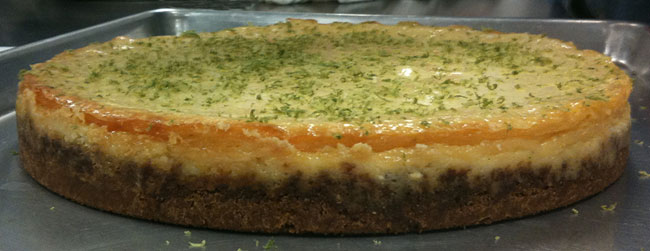
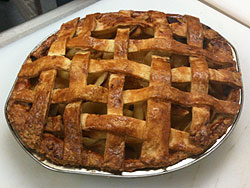 Apple Pie
Apple Pie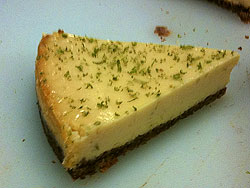 Key Lime Pie
Key Lime Pie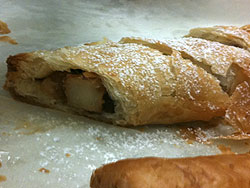 Pear-Cranberry Strudel
Pear-Cranberry Strudel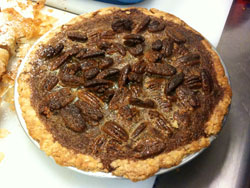 Sweet-Potato-Pecan Pie
Sweet-Potato-Pecan Pie
7 Comments
You’re killing me. I was going to take that class but my husband’s work schedule changed last minute and I missed the first two weeks then wasn’t sure if I could still barge in.
I’ll live vicariously. *sigh*
Its a well attended class – right now there are 42 people in the class. Its right on the verge of being too many in my opinion. On the first day there were an additional 20 or so people that showed up and are on the waiting list for this class. The teacher said that its unusual to have this many people but wanted to accommodate as many as possible. Its well worth it though.
When the class is offered again I suggest getting there an hour or so early to ensure you get in. The previous class – which is the second part of this class, covering chocolate, cakes and sugar work – only had 9 people at the end of the class, so its definitely depends on the the class and the year.
Nice blog you have by the way. Love all the pictures and the variety of topics:)
Well I had convinced myself that the class would be lame to make myself feel better, but now you’ve gone and ruined that ;p
I will have to try for it next semester!
Thanks for visiting my blog, too. =)
But is it as good as Mom’s?
You are making some yummy stuff. And everything looks so pretty. Your class sounds great! Are your pants going to fit when you are done? lol
I dont think anything is as good as Moms. Probably because there are not memories attached to the recipe – but the Key Lime pie was great. I did not try the Apple as I only got one piece and gave it to a co-worker who loves apple pie. Im making him a pie tonight so Im going to take a piece of it for myself. The crust I did try and it was fairly good. Moms is all butter and the one in class was part shortening and part butter. I think I still like Moms better. The Pecan one was too hot to try yet so we stuck it in the freezer and will get it on Thursday – but it did look and smell good.
Im going to have to start limiting my baking or I wont fit in my jeans much longer. Outside of class this week I made pumpkin bread (not putting that on the blog because I did not care for the flavor – it was gluten free), graham crackers, a key lime pie and tonight will be the apple pie. I give most of it away – but Im going to have to start going to the gym twice a day if I don’t slow down!
Actually, Moms crust is all shortening with no butter. But, everything is good with butter!
Well the recipe she gave me about 10 years ago is all butter… so she must have more than one. Here is the one she gave me… woops just went and got the recipe and here is what it says (in my hand writing):
1 Cup Flour
1 Cup Butter (shortening)
Dash of salt
Ice water
So apparently I changed it and did not even know I was making it wrong all these years… LOL. Well next time you make a pie do 50% butter and 50% shortening… its amazing (my Apple Pie post will be up tomorrow that has the recipe I used for it and I must say I loved it – the pictures turned out great too).